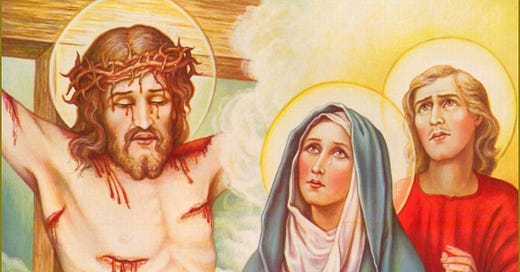Introduction
The Catholic Church has often faced the accusation of worshiping Mary, the mother of Jesus. However, a closer examination of Catholic doctrine and practice reveals that this accusation is based on a misunderstanding. As an expert Catholic theologian with extensive knowledge in Theology and Biblical Languages, I aim to demonstrate why it is theologically impossible for Catholics to worship Mary, and how their veneration of her is distinct from the worship due to God alone. This article will delve into the nuances of Catholic teachings, scriptural foundations, historical context, and examples from the life of Jesus Christ.
Understanding Worship (Latria) vs. Veneration (Dulia) and Hyperdulia
Catholic theology makes a crucial distinction between latria, dulia, and hyperdulia.
Latria refers to the worship and adoration that is due to God alone. This form of worship acknowledges God's supreme divinity and is reserved exclusively for Him. The term derives from the Greek word "λατρεία" (latreia), signifying the highest form of reverence.
Dulia, on the other hand, refers to the veneration or reverence given to the saints. It acknowledges their exemplary holiness and closeness to God but does not equate them with God. The term comes from the Greek "δουλεία" (douleia), meaning service or honor.
Hyperdulia is a special form of veneration reserved for Mary, recognizing her unique role as the Mother of God and her unparalleled closeness to Jesus. This term indicates a higher level of veneration than dulia but is still categorically distinct from latria.
The distinction between latria and dulia is clear and meticulously maintained in Catholic teaching, ensuring that worship is directed to God alone. This theological framework underscores the importance of differentiating between adoration and veneration.
Scriptural Foundations
Catholic devotion to Mary is deeply rooted in Scripture, beginning with the Annunciation. Luke 1:28 records the Angel Gabriel's greeting to Mary: "Hail, full of grace, the Lord is with thee." This greeting underscores Mary's unique favor with God, setting her apart from all other creatures. The term "full of grace" (κεχαριτωμένη, kecharitōmenē) suggests a state of divine grace bestowed upon Mary from the moment of her conception.
In Luke 1:48, Mary herself proclaims: "For he has regarded the low estate of his handmaiden. For behold, henceforth all generations will call me blessed." This passage illustrates the honor given to Mary throughout the ages, fulfilling her prophecy of being called "blessed" by all generations. The Greek term "μακαριοῦσιν" (makariousin) indicates a state of blessedness and happiness, recognized by future generations.
Historical and Theological Clarification: The Role of Mary
Mary's role in Catholic theology is that of a mediator and intercessor, not a deity. The Church teaches that Mary intercedes for the faithful, bringing their prayers to her Son, Jesus Christ. This is akin to asking a friend to pray for you, a practice rooted in the Christian understanding of the communion of saints.
The Catechism of the Catholic Church (CCC 2677) emphasizes that when Catholics pray to Mary, they are ultimately seeking her intercession to God. The phrase "To Jesus through Mary" encapsulates this understanding, directing all worship and adoration to Jesus while seeking Mary's intercessory support. This practice is deeply rooted in the early Christian tradition, where the Church Fathers like St. Augustine and St. Ambrose highlighted Mary's unique role in the economy of salvation.
Examples from the Life of Jesus
Jesus' own interactions with Mary further illuminate her role. At the wedding at Cana (John 2:1-12), Jesus performs his first miracle at Mary's request, transforming water into wine. This event demonstrates Mary's influential intercession and Jesus' willingness to respond to her requests. However, it does not imply that Mary is worshiped; rather, it shows her unique relationship with Jesus. The Greek term "Τί ἐμοὶ καὶ σοί, γύναι;" (Ti emoi kai soi, gynai?) is often translated as "Woman, what does this have to do with me?" indicating a respectful yet distinct relational context between Jesus and Mary.
Moreover, on the cross, Jesus entrusts Mary to the care of the beloved disciple, John (John 19:26-27). This act symbolizes Mary's spiritual motherhood of all Christians, furthering her role as an intercessor and advocate, but not as an object of worship. The phrase "Ἰδοὺ ἡ μήτηρ σου" (Idou he mēter sou), meaning "Behold, your mother," establishes Mary's maternal role within the Christian community.
Mariology and its Development
The development of Mariology in the Catholic tradition further emphasizes her unique but non-divine role. Key dogmas such as the Immaculate Conception and the Assumption highlight Mary's singular grace and destiny, but they do not elevate her to the status of divinity. The Immaculate Conception, defined in 1854 by Pope Pius IX, teaches that Mary was conceived without original sin. The Assumption, defined in 1950 by Pope Pius XII, teaches that Mary was assumed body and soul into heavenly glory. Both dogmas reinforce her special role and purity but maintain the clear distinction between Creator and creature.
Conclusion
Catholic doctrine and practice make it unequivocally clear that worship (latria) is due to God alone, while veneration (dulia) and hyperdulia are appropriate expressions of respect and honor towards the saints and Mary, respectively. The distinct theological categories, scriptural foundations, historical context, and examples from the life of Jesus all support the impossibility of Marian worship within Catholicism. Thus, the Catholic Church's devotion to Mary is a profound expression of honor and reverence, firmly rooted in the love and worship of God alone.
By understanding these theological nuances, it becomes evident that the veneration of Mary is not only doctrinally sound but also deeply enriching to the Catholic faith, fostering a closer relationship with Christ through the example and intercession of his most holy mother.




Thank you for this.